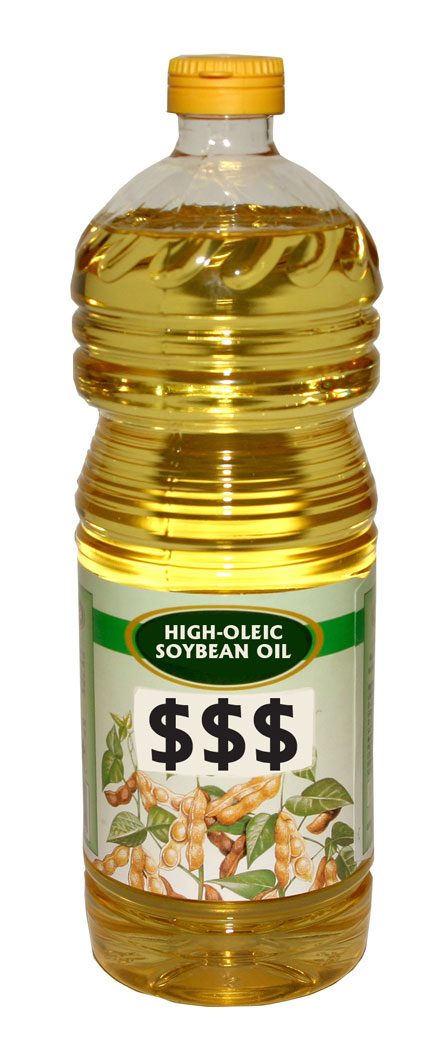|
|
High-oleic soybean oil’s slippery slopeby Ari Levaux Oleic acid is named after olive oil, the most concentrated naturally occurring source of this monounsaturated fat. Widely lauded for its healthfulness and flavor, olive oil offers many reasons to love it. But it’s the oleic acid that industrial food processors are drooling over – and not necessarily for its supposed heart-friendly virtues. Oleic acid is stable at room temperature for long periods of time, and can endure repeated bursts of heat without breaking down. High-oleic oils first entered the market about 10 years ago as the industry attempted to phase out its use of partially hydrogenated oils – aka margarine – which have been shown to contain dangerous levels of trans fats. Several high-oleic oils have entered the market to fill this void of shelf- and heat-stable fats, including oils made from sunflower, corn and canola seeds. These high-oleic oils have become the industry’s preferred substitute for partially hydrogenated vegetable oils, and are used in all manner of processed food, especially snack foods that need long shelf lives, and in the vats of hot oil used to deep-fry food. While these new oils lacked trans fats, they were still not ideal for the industry, explains Melanie Warner in Pandora’s Lunchbox: How Processed Food Took Over the American Meal. Regular soy oil, Warner notes, is the cheapest form of fat there is, making it the obvious first choice for industry. Soybeans are also one of the best sources of protein in the plant world, which is why pressed soy cake is so valuable as animal feed. Other products, like lecithin and vitamin E, are extracted from soy and sold separately. But despite soy’s multi-market upside, the industry is heavily subsidized. And since everything from burgers to fries to buns contain soy oil, subsidizing soy equals subsidizing fast food. The same can be said about junk food. Enter high-oleic soybean oil. There are two new types, DuPont’s Plenish and Monsanto’s Roundup-ready Vistive® Gold. Both are made through the genetic modification technique called gene silencing, but there are slight differences between them. Plenish boasts higher oleic acid levels, on par with olive oil at 75 percent. Vistive® Gold is lower in saturated fat, which many people still believe is bad for you. Vistive® Gold also boasts lower levels of linoleic acid, aka omega-6 fatty acid. Efforts by Monsanto and Dupont to perfect high-oleic soybean oil, Warner told me via email, are “part of a decades-long struggle by the food industry to make soybean oil suitable for processed foods. Ever since trans fats became a health concern, the oil industry has been trying to find a way to prevent soybean oil from going rancid in food and in frying vats.” Among its many industry-friendly qualities, high oleic soy oil can withstand up to three times as many fryings as the current industry standard. Thus, vegetable oil costs for processed foods could be cut by as much as a third in the coming years, as these products ease their way into our lives. The relatively new “getting to know you” process between humans and seed oils has already delivered an unexpected series of problems. First there were the issues with trans fats. More recently, problems created by linoleic acid have been discovered, including the creation of toxic aldehydes when linoleic acid is heated. Most seed oils contain linoleic acid. Olive oil does not. And to its credit, neither does Vistive® Gold. Although soy has been eaten for thousands of years in Asia, it’s mostly been in fermented forms like soy sauce, tempeh, natto, miso and tamari. Even tofu was once commonly fermented. But soy oil was rarely consumed. “The only vegetable oil eaten in any significant quantity was olive oil,” Warner writes. She quotes Joe Hibbeln, acting chief of nutritional neurosciences at a research division of the National Institutes of Health, who calls the rise of soybean oil “the single greatest, most rapid dietary change in the history of Homo sapiens.” The many adjustments, dead-ends and wrong turns that have occurred as Homo sapiens have tried to adapt to vegetable oils might be a clue that we’re trying to fit a square oil into round bodies, so to speak. Our never-ending quest to tweak away health complications and bad odors, and insert supposedly healthful qualities, may turn out to be a fool’s errand. Soy is the backbone of junk food and fast food, and high-oleic soybean oil is poised to make related businesses more profitable. Whether the oil turns out to be good for the people who consume it remains to be seen. |


